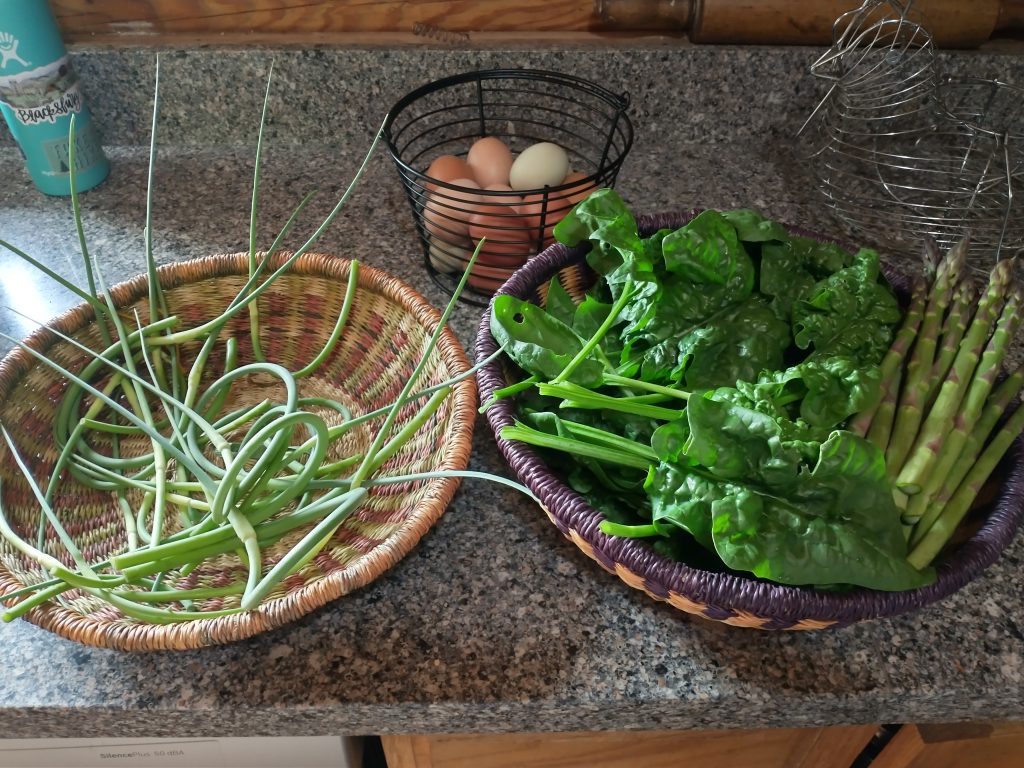Typical spring here, hot and humid one day and chilly and gray the next, but the garden grows. Except for the corn. Out of 4 rows in a 12 X 4 foot bed, only two seeds sent up blades. We were due for thunderstorms a couple of days ago, so the bed was reseeded. This may be the last time I try corn. Year before last, there was nothing, last year some came up, but the harvest was pretty paltry for the space it consumed. The only year that corn has ever been “successful” though marginally was the year of the popcorn.
The seed starts for squash, tomatillos, pumpkins, tomatoes, and peppers were all successful and are doing well planted in the beds. The cucumbers failed on first start, but there are several strong seedlings putting out secondary leaves that are currently being hardened off and soon they will be planted in the last bed.
The motivation for the garden has been hard to come by this year, and since I am currently unable to be out in the sun due to a chemo cream use on my face, I have to heavily cover with mineral sunscreen, wear a huge hat and limit my exposure. Sunburns as a kid camping with family, as a young adult working as a lifeguard, have come back to haunt me. Usually, anything found by the dermatologist is zapped with liquid nitrogen, but this time is wasn’t in a place they want to spray. At any rate, early or late, very protected sessions are being done. As an adult, I wear long sleeves nearly year round and always wear a hat with a brim when we are out walking. Sun damage from years ago revisits as we age.
Peas are heavy with blooms and though they are supposed to be a free standing variety, they have toppled all over each other. Soon, peas will be harvested. One of the varieties of spinach is bolting as is the lettuce. The beans are up. The tomatoes, peppers, basil, squash, and tomatillos have been mulched with clean straw, thanks to a friend that was able to get me a couple of bales yesterday. Part of a bale was used to clean the hens coop, a few flakes as mulch and the rest set back in the dry garage for further coop cleaning and garden mulching.

Now if I can just get the paths under control, figure out how to kill off the smartweed and creeping charlie, I will be happy. As it is upper 70’s today and tomorrow with bright sun, the paths were all sprayed with white vinegar and dish soap. If that shows any level of success, it will be repeated until I win, vinegar is cheap and safe. A truck load of wood chips would be great to have, to put about 4 inches between all the beds. The other frustrating area is the tall grass that grows up the welded wire fence. The line trimmer can’t get under the fence and if it hits the wire, it breaks off the trimming line. I don’t want to use chemicals like Liquid Fence, nor do I want to take down the fence and reset it an inch or two off the ground so I can weed under it. I envy neat gardens with no weeds, no grass in-between beds, no fence needed to thwart the deer, groundhogs (saw one today in the yard), and free ranging chickens. Perhaps the electric mesh type moveable fencing that can be moved away, allow mowing, then re-set would do the trick. I already have the 6V charger. Maybe if the vinegar trick works and I can get woodchips, cardboard can be slipped under the fence wire, heavily mulched on both sides out maybe far enough to keep an edge would work.
The bees are again protected from the resident bear. A new battery for the 12V charger was ordered and installed. Tested on the deck, it showed a strong charge, so it was taken back to the bee yard, rehung, and attached to the electric fence wire. When it was turned on, it showed only marginal charge on the fence. Because it was a new solar charged battery, it was left alone to charge for a couple days and still only marginal. This morning, the piece of line that connects the wire to the charger was replaced and the fence is again hot. Hopefully, 12 V will deter the furry beasts.




